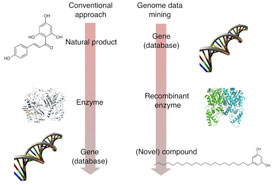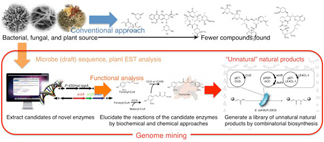Chemical Biology

- account_circleNobutaka FunaPhD, Assoc. Prof.
- Website:https://dfns.u-shizuoka-ken.ac.jp/labs/chembio/
- Mail:funa@u-shizuoka-ken.ac.jp
- Phone:+81-54-264-5552
Genome mining
Using microorganisms’ genomic data to discover novel biosynthetic enzymes
- 1. Biosynthesis of natural products
Here we pursue the biosynthesis of natural products, with the ultimate objectives of probing, understanding, and manipulating the genetic machinery of secondary metabolite biosynthesis in bacteria, fungi, and plants.
- 2. Characterization of novel natural products by utilizing genome sequence data
In the past, natural-products chemists have unearthed many compounds from natural sources. However, this process involves laborious purification steps to find a desired “grain of sand” in a metabolite beach. Recent genomics research has resulted in the deposition of a huge quantity of DNA sequencing data from a wide variety of organisms into publicly accessible databases. Using this insight from genome sequences, we are screening novel biosynthetic enzymes. This methodology, called “genome mining,” may offer an alternative route to identifying new compounds of biological origin.
- 3. Combinatorial biosynthesis of “unnatural” natural products
Today, researchers’ understanding of polyketide biosynthesis has reached a point where we can now manipulate polyketide biosynthesis to generate libraries of “unnatural” natural products. Our research group is currently focused on studying type III polyketide synthases to produce “unnatural” forms of plant polyketides.
- Figure 1
- Comparison of reverse genetic and genome mining.

- Figure 2
- Overview of genome mining.

References
- Biosci. Biotechnol. Biochem., 74, 641–645 (2010)
- Proc. Natl. Acad. Sci. USA, 105, 871–876 (2008)
- Chem. Biol., 14, 613–621 (2007)